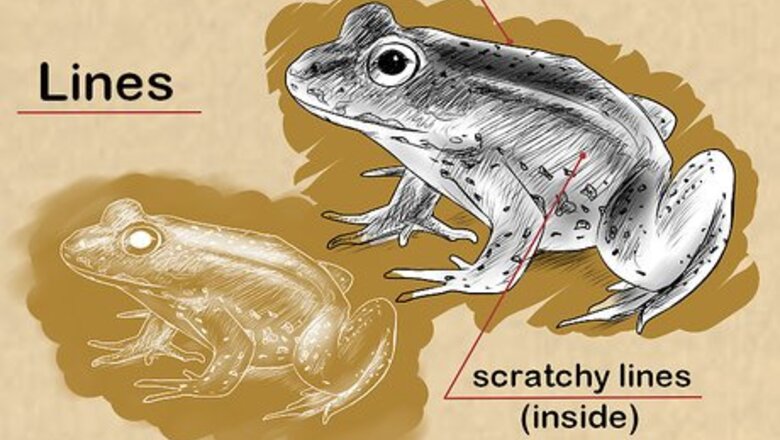
views
Describing a Work’s Formal Elements

Make notes about the use of line. Line is one of the most foundational elements, so a reflection on it is a great place to start. You could consider things like: What kind of marking techniques were used? For example, are the lines smooth, or scratchy? Are there a range of thick and thin lines, or are they generally the same thickness? Do the lines recall another artist’s style?

Jot down your thoughts on the use of tone. When annotating art, “tone” refers to the piece’s use of lights, darks, and shading. As you observe the piece you are working with, notice the way it creates highlights, dark areas, and shades in between. Is the piece predominantly light, dark, or somewhere in the middle? Are there any highlights or dark areas that serve as a focal point in the work? Are there gentle gradients of tone, or sharp shifts from light to dark?

Describe the forms used in the work. You can look to see if there are any regular forms in the work, like squares or triangles. Make note whether these are pure geometric forms, or only suggestions of them (like a house may suggest a square shape). A work might also contain organic (freeform) shapes. If so describe them as best you can, asking questions like: Are the forms rounded or angular? Are they solid or broken up? Are the forms flat, or do they have depth?

List the colors used. Examine the full range of colors used in the artwork. Try to categorize them. For instance, are they mostly primary colors (red, yellow, blue), or a set of complementary colors (like red and green, or blue and orange)? You can also ask: Is the piece is monochromatic (only uses one color, in various shades)? Are warm colors (yellow, orange, and red) or cool colors (blue, green, purple) prominent? Does the work make use of earth tones?

Describe the textures you see. Artworks have real textures, or the way the work itself feels, such as the smoothness of a polished stone sculpture or the roughness of an oil painting. A work can also have represented textures (for instance, the way a painting might depict the softness of fabric). Either way, describe them: Are they smooth, rough, or both? Do the textures recall natural or manmade objects? Are the textures related to the subject matter in any way?

Look for a pattern within the work. Pattern could mean a repeated arrangement of colors, shapes, lines, textures or other elements. If there is a pattern, it might be obvious, as in a floral print or checkerboard. The pattern might also be more subtle, like the way a piece could alternate between areas of red and areas of blue.

Describe the overall composition. How are the elements in the image or work arranged? Is the work more or less “flat,” or do you see a foreground, middleground, and background? Are objects in the image close together, or far apart? Is the work balanced, or are important elements mostly to one side or the other?

Put your thoughts together. Whether you are annotating your own work or a piece by another artist, you'll want to write something about the formal elements of the work. Once you have gathered your thoughts on line, form, pattern, and the other elements, put together a solid paragraph or two discussing how these are used in the artwork.
Analyzing Your Creative Process

Summarize what you have made. No annotation to your artwork would be complete without a reflection on what you have created. Start by writing a brief description of the piece itself, including its medium, basic subject matter, and style. For instance, you might write “My piece title Constellation #3 is an oil painting on masonite board, with embedded nails. It depicts an angel in a night sky. I rendered the work using a rough impasto painting technique and a cool color palette.”

Tell the story of your artistic process. For annotations, how you made the work matters as much as what you made. Spend some time describing the process you used, step by step. This can be a simple narrative of the work’s development: ”I started by laying black gesso over the masonite panel. I drove nails through the panel at random intervals to create texture. I then blocked out the subject’s basic form using a light wash of thinned paint. Finally, I built up the subject’s form through successive layers of thick paint.”

Mention any sources of inspiration. In creating your work, you might have had other artworks or artists in mind. Or, you might have been responding to something from culture, like a movie, historical event, or performance. Make sure to give a brief statement that explains how you incorporated these points of reference. You can also mention if the piece is related to other artworks you’ve made. For instance, you might have been working on a series of paintings depicting night sky scenes.

Acknowledge what you learned from making the piece. Annotations are often used as part of art education. Even if you are writing them for yourself, taking a moment to think about what you learned from the piece can help you become more self aware as an artist. For instance, perhaps you learned intricate details about how oil paint of various thicknesses dries at different rates.

Evaluate your work. Being able to honestly and accurately critique your own work is as valuable as evaluating the work of others. When annotating your artwork, you can ask yourself a couple simple questions: What have I done well in this work? Try to list a few specific points. What could I improve if I did the work over again? Here too, list some specifics.

Write it all out. After you've thought about how you developed your work, your sources of inspiration, and what you learned form the piece, devote another couple of paragraphs in your annotation to these reflections. For instance, you can have one paragraph that describes your process and inspiration, and another that evaluates your work and discusses what you learned or how you would create the piece differently if you were to do it over again. If you are writing about your own work, you can stop here. Make sure to proofread your annotation carefully, correcting any spelling or grammar mistakes, and polishing the style of your sentences to make sure they are clear and flow well.
Annotating Another Artist’s Work

Give some background information. When annotating other artists’ work, you’ll want to consider its context. What is the work’s title? Who created it? What do you know about the artist’s biography, or the history of this work?

Describe the work. Draw on your knowledge of the elements of art to write an account of the work itself. Describe its medium and overall composition as well as things like its use of color, line, texture, and form.

State the artwork's meaning in your own words. What is the subject or theme of the work? Is if focused on the depiction of an object or individual? Does a tell a story? Or is the work more abstract? Consider for a moment what the artist seems to be saying in the work, and summarize it as a message. You could also mention here whether the work seems to relate to something from culture or history, or to reference other artworks.

Evaluate the artwork. Mention which aspects of the work seem to be most successful. Then, ask yourself what you would have done differently had you created the work. You can also mention what you would ask the artist about the work, if you were able to.

Write your thoughts out. If you are annotating the work of another artist, instead of reflecting on your own creative process, you'll devote a couple of paragraphs to an analysis of the piece you're studying. For instance, you could begin with a paragraph that describes the artist's background, and the work itself. You could then follow with a paragraph that gives your interpretation of the work's meaning, and evaluates its strengths and how you might have approached the work differently. After you have the annotations written out, make sure to proofread for spelling and grammar. Polish your sentences stylistically as well so that your writing sounds clear and lively.




















Comments
0 comment